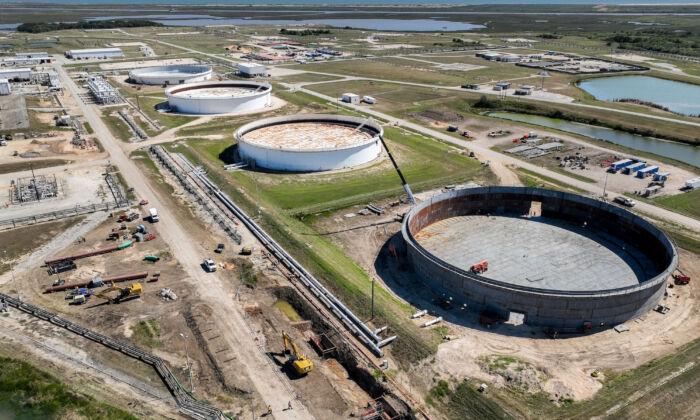The U.S. Department of Energy (DOE) has announced that it intends to buy oil to replenish the country’s Strategic Petroleum Reserve (SPR), which has been depleted to multi-decade-low levels.
When Joe Biden became president in January 2021, America’s SPR reserves stood at 638 million barrels. In 2022, the administration sold a record 180 million barrels from the reserves in a bid to tame rising gasoline prices.
The SPR sales had angered GOP members who blamed the administration for leaving the country vulnerable to a potential oil supply crisis.
DOE’s three million barrels of oil purchase is part of the Biden administration’s “three-part replenishment plan,” said a DOE May 15 press release.
“The three-part replenishment strategy includes: (1) Direct purchases with revenues from emergency sales; (2) Exchange returns that include a premium to volume delivered; and (3) Securing legislative solutions that avoid unnecessary sales unrelated to supply disruptions so as to strategically maintain volume.”
The DOE claims that it is aiming to repurchase crude at a lower price than the average of roughly $95 per barrel the SPR reserves were sold in 2022.
Meanwhile, the department has also secured the cancellation of 140 million barrels of oil per congressionally mandated sales scheduled for fiscal years 2024 through 2027.
The Right Price
There has been a significant delay in replenishing the nation’s strategic reserves. The reason for the delay was attributed by administration officials to waiting for the right price.The administration had earlier stated that it would refill the SPR if oil could be purchased at around $70 per barrel.
DOE Mismanagement of SPR
On May 8, House Energy and Commerce Committee Chair Cathy McMorris Rodgers (R-Wash.) and Senate Energy and Natural Resources Committee Ranking Member John Barrasso (R-Wyo.) sent a letter (pdf) to the Government Accountability Office (GAO) asking that the agency evaluate the DOE’s mismanagement of SPR that has “undermined America’s energy security.”The letter pointed out that under the Biden administration, the DOE has overseen the largest SPR drawdown in American history by selling off over 250 million barrels of oil without having a “credible plan to replenish the stockpile.”
“We are concerned that the rapid depletion of the SPR may have caused structural damage to the SPR’s pipelines and caverns, compromising its ability to meet its energy security mission in the event of a true energy supply disruption,” the letter said.
“The SPR consists of subterranean salt caverns filled with oil, and a complex system of wells, pipelines, and pumps that use water and brine to direct the flow of oil to where it is needed. Each drawdown has the potential to degrade the SPR’s storage and distribution capabilities, as pressurization, corrosion, and consequences of repeated use erode the SPR’s physical integrity.”
The letter also criticized the DOE for putting on hold the Life Extension II program sanctioned by Congress in 2015. Life Extension II authorized $1.4 billion so that the DOE can conduct an SPR modernization program.
“Today’s announcement advances the President’s replenishment strategy following his historic release from the SPR to address the significant global supply disruption caused by Putin’s war on Ukraine and provide a wartime bridge for domestic production to increase,” said the DOE press release.
Although Biden has placed the blame for high oil prices on the Russia-Ukraine war, experts have pointed to several policies the administration has undertaken that have contributed to price hikes, including the cancellation of the Keystone XL pipeline, restricting domestic production through increasing regulatory costs and issuing moratoriums on leasing activities, and enforcing climate change agenda initiatives, while depending excessively on foreign oil producers.





